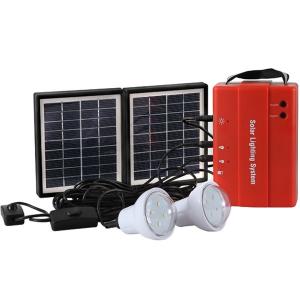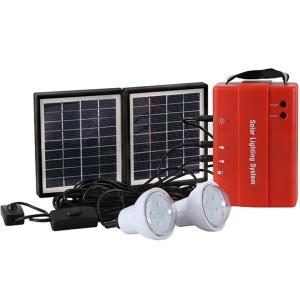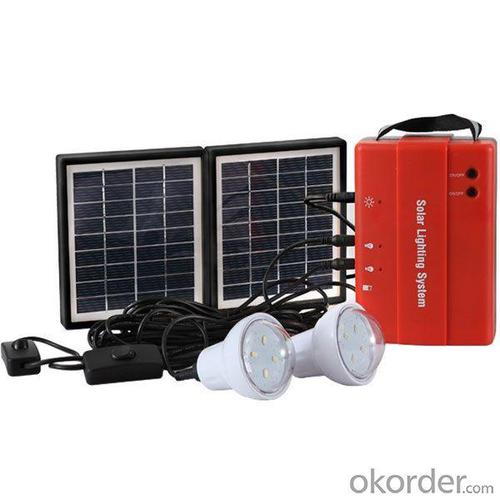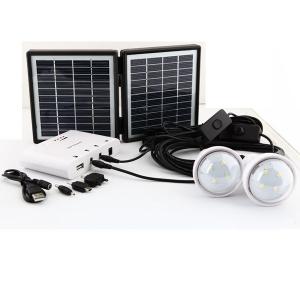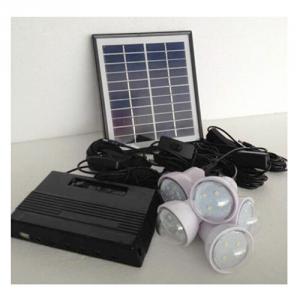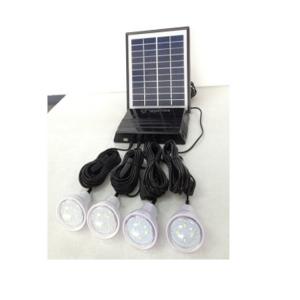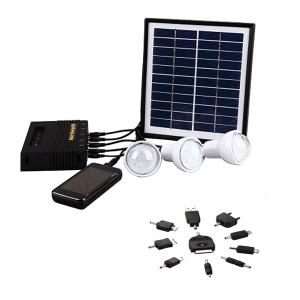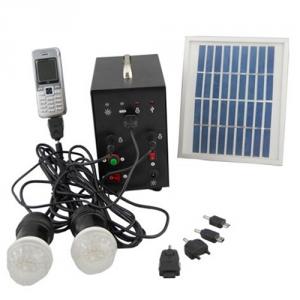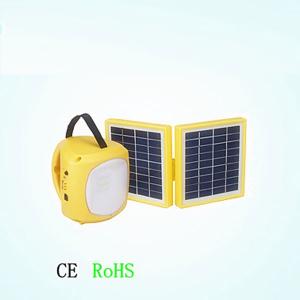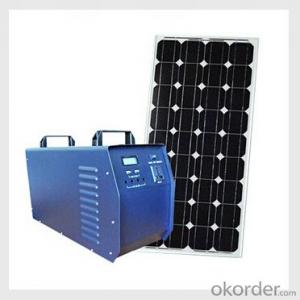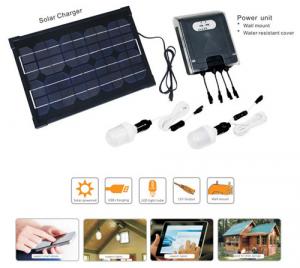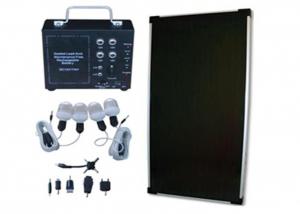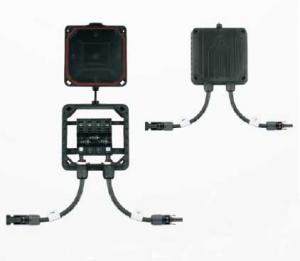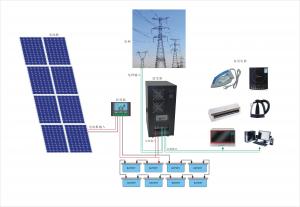Sun Tec Solar Energy Systems 3.4w Solar Lighting System with Mobile Charge LED Bulb Light Outdoor 3.4w Solar Panel 4500mAh Battery CE
- Loading Port:
- Shenzhen
- Payment Terms:
- TT/LC
- Min Order Qty:
- 100Sets set
- Supply Capability:
- 20000 SETS Per Month set/month
OKorder Service Pledge
OKorder Financial Service
You Might Also Like
This 3.4w 9v solar panel solar lighting system with mobile charge 4500mAH 6v and 2 led globe bulbs. This portable solar energy system can generate power for 2 LED bulbs, it can work 15 to 30 hours every day.
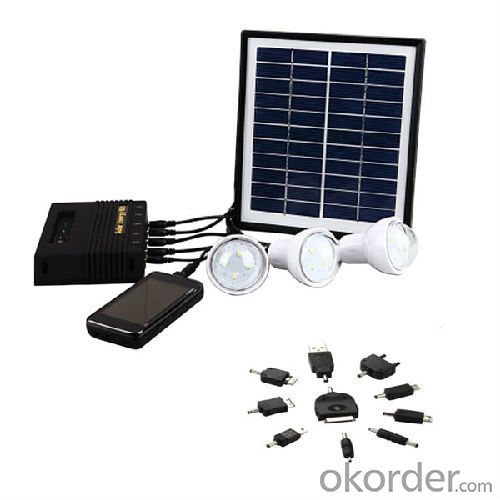

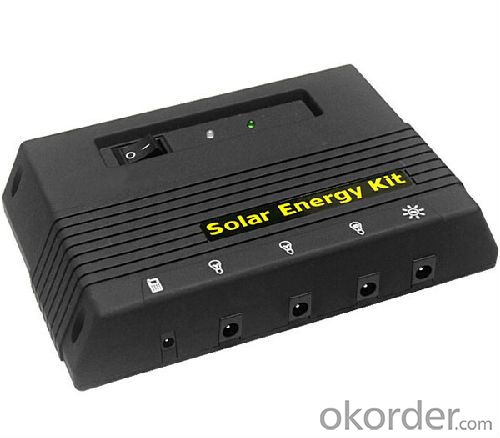
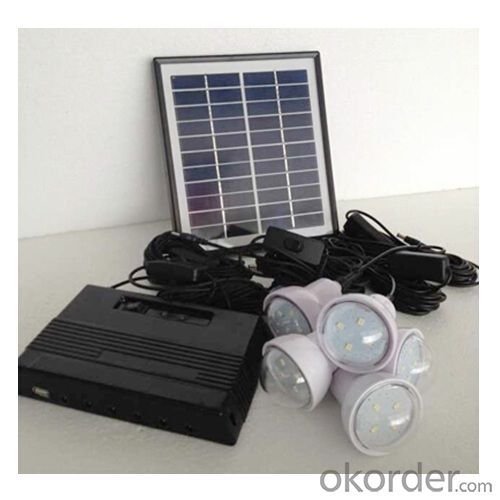
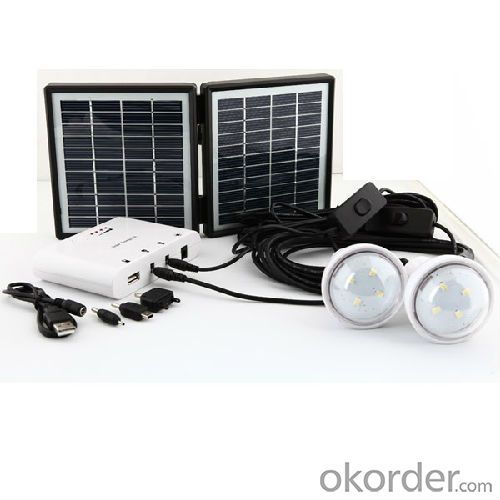
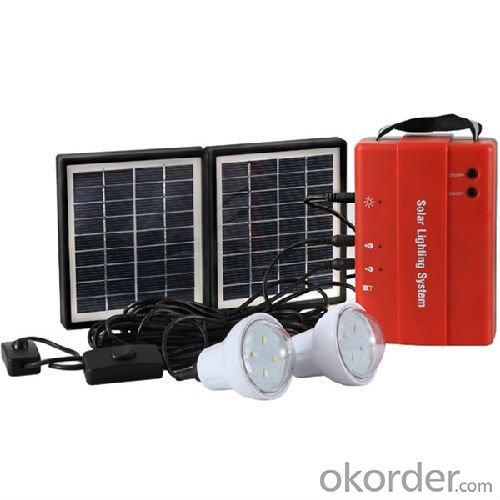
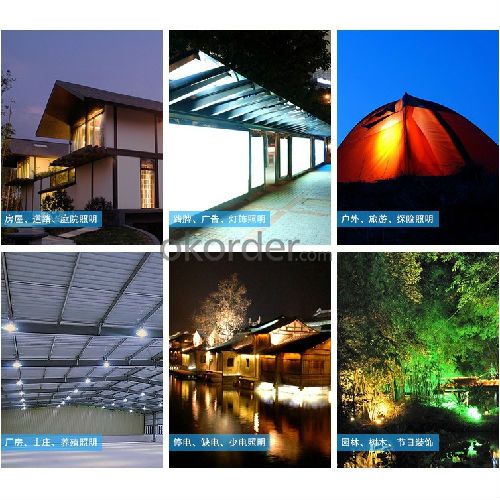
Parameter
1, Rechargeable by solar or AC adaptor;
2 With 10 in 1 USB mobile phone charger
3. Housing material: ABS;
4. Battery: 4.5AH/6V maintenance free Lead-acid ;
5. Lighting time: 30 hours after fully charged; 10hrs after one day charge by sun.
6. Accessory: two bulbs with 5M long cable(with switch on the cable)
7.Over charge and over discharge protection.
| Application: Home |
| Output Voltage (V): 9V |
| Load Power (W): Depends |
| Solar Power (W): 3.4W |
| Work Time (h): 15-30hours |
| Solar Panel: 9V 1.7W *2pcs |
| Battery type: 6V 4.5AH Lead-acid battery |
| Material: ABS |
| Usage: indoor home lighting & outdoor lighting |
| Light source: 0.9W 90lumens |
| Color: red |
| Optional charging: 8V AC adaptor |
| IP level of solar panel and bulb: IP65 |
| IP level of control box: IP44 |
| USB output: 5V 500MA |
Feature
1, Foldable solar panels
2, With 10 in 1 USB phone charger and 2pcs of LED bulbs
3, CE
Usage/Applications
Rural homes, campers, fishermen, outdoor campaigns or activities, etc. Remote area, mountainous area, desert area, grassland area,
Village, country area, Camping, outdoor activities, travel, Lighting at night.
Customized options
1. OEM/ODM available;
2. It's also available to customize your own solar lighting systems, solar lanterns, or any solar lighitng products by giving us solar lights picture / 3D draft / technical datas.
Packing & Delivery
Package:
1* solar panel
1* portable system box
2* LED bulbs with on/off button on cable
inner box size: 190*140*170mm
12pcs/carton
carton size: 580*305*355mm
Delivery:
|
Shipping Service |
Estimated Delivery Time |
|
DHL |
2-8 business days |
|
FedEx |
3-8 business days |
|
TNT |
2-10 business days |
|
UPS |
1-7 business days |
|
EMS |
6-14 business days |
|
ePacket |
7-12 business days |
|
China Post Air Mail |
7-15 business days |
|
China Post SAL |
14-30 business days |
|
Air freight |
3-10 business days |
|
By Sea |
30-40 business days |
1. 3-5 business days for Sample Orders; 7-30 business days for Bulk Orders for Bulk Orders.
2. "Business days" means Monday-Friday, excluding holidays.
3. DHL and UPS cannot ship to military or P.O. boxes address
4. The Shipping Service above is for reference only, for any other questions, please feel free to contact us.
Factory
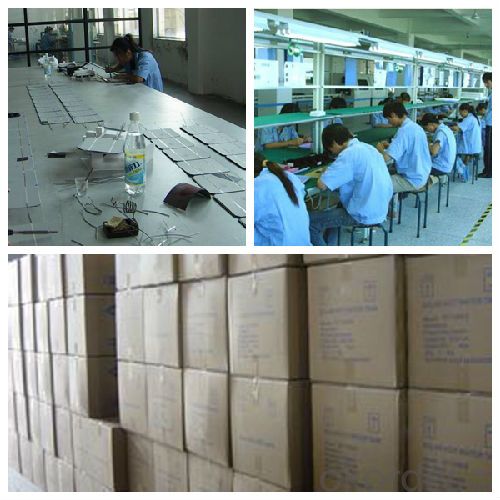
- Q: Can solar energy systems be used for powering off-grid eco-schools?
- Yes, solar energy systems can definitely be used for powering off-grid eco-schools. Solar panels can be installed on the roofs or grounds of eco-school buildings to capture sunlight and convert it into electricity. This renewable energy source provides a sustainable and environmentally friendly solution for powering the school's lighting, heating, cooling, and electrical needs. Additionally, any excess energy generated can be stored in batteries for use during cloudy days or at night. Solar energy systems are an ideal choice for off-grid eco-schools as they reduce reliance on fossil fuels, lower energy costs, and promote a greener and more sustainable future.
- Q: Can solar energy systems be financed or leased?
- Certainly, it is possible to finance or lease solar energy systems. Various companies provide financing choices for individuals and enterprises interested in installing solar panels and similar energy systems. These financing alternatives enable customers to divide the system's cost over a specific duration, thus rendering it more economically feasible. Furthermore, leasing arrangements are attainable whereby a third-party company owns and maintains the solar panels, and the customer pays a monthly fee to lease the system. Consequently, such financing and leasing alternatives have enhanced the accessibility of solar energy to a broader spectrum of individuals, significantly contributing to the rapid expansion of the solar industry in recent years.
- Q: How does the efficiency of solar panels vary across different installation tilts?
- The efficiency of solar panels can vary across different installation tilts due to several factors. The ideal tilt angle for solar panel installation depends on the geographical location and the intended purpose of the solar system. In general, solar panels produce the highest energy output when they are installed at an angle that maximizes the amount of sunlight they receive throughout the day. The optimal tilt angle for solar panels is typically equal to the latitude of the location, ensuring that the panels are perpendicular to the sun's rays during peak sunlight hours. However, the efficiency of solar panels can be affected by deviations from the optimal tilt angle. If the panels are installed at a steeper tilt angle, they may receive more direct sunlight during certain parts of the day, resulting in increased energy production. Conversely, if the panels are installed at a shallower tilt angle, they may receive more diffuse sunlight, which can reduce their efficiency. Furthermore, the efficiency of solar panels can also be influenced by the time of year. In many locations, the sun's position in the sky changes throughout the year, resulting in varying optimal tilt angles. Some solar systems are designed with adjustable mounting systems that allow for seasonal changes in tilt angle to maximize energy production. It is important to note that while the efficiency of solar panels can vary across different installation tilts, the overall energy output of a solar system is also influenced by other factors such as the quality of the panels, the cleanliness of the panels, and the presence of shading. Proper maintenance and regular monitoring of the system can help ensure optimal performance regardless of the installation tilt.
- Q: Can solar energy systems be used for powering breweries?
- Yes, solar energy systems can be used for powering breweries. Solar panels can generate electricity that can be used to power various equipment and processes in breweries, including heating water, running pumps, and powering lights. Implementing solar energy systems can help breweries reduce their environmental impact, lower their energy costs, and promote sustainability.
- Q: Can solar energy systems be integrated with existing electrical systems?
- Yes, solar energy systems can be integrated with existing electrical systems. They can be connected to the grid or used in standalone systems, depending on the specific requirements and goals of the user. Integration typically involves the installation of solar panels, inverters, and other necessary equipment to convert sunlight into usable electricity. This integration enables the generation of renewable energy and reduces reliance on traditional power sources.
- Q: Can solar energy systems be used in areas with high levels of air pollution?
- Yes, solar energy systems can be used in areas with high levels of air pollution. Solar panels are designed to generate electricity from sunlight, regardless of the air quality. While air pollution can slightly reduce the efficiency of solar panels by blocking some sunlight, it does not render them completely ineffective. However, regular cleaning and maintenance of the panels may be required to ensure optimal performance in polluted areas.
- Q: Can solar energy systems be used in areas with strict environmental regulations?
- Yes, solar energy systems can be used in areas with strict environmental regulations. In fact, solar energy is often encouraged and incentivized by such regulations due to its clean and renewable nature. These systems do not produce harmful emissions or pollutants, making them an environmentally friendly option that aligns with strict regulations aimed at reducing carbon footprint and promoting sustainable practices.
- Q: Are solar energy systems noisy?
- No, solar energy systems are not noisy. They operate silently as they convert sunlight into electricity without any moving parts or mechanical components.
- Q: What are the main components of a solar energy system?
- The main components of a solar energy system include solar panels, an inverter, a battery (optional), and a charge controller.
- Q: Can solar energy systems be used for powering outdoor surveillance cameras?
- Yes, solar energy systems can definitely be used for powering outdoor surveillance cameras. Solar energy systems consist of solar panels that convert sunlight into electricity, and this electricity can be used to power various devices, including outdoor surveillance cameras. By installing solar panels near the cameras, the captured sunlight can be converted into electrical energy, which can then be stored in batteries or used directly to power the cameras. This eliminates the need for traditional power sources or running electrical wires to remote locations, making it a cost-effective and eco-friendly solution. Additionally, solar energy systems can provide a reliable and continuous power source, even in areas with limited access to electricity, ensuring uninterrupted surveillance capabilities.
1. Manufacturer Overview
| Location | |
| Year Established | |
| Annual Output Value | |
| Main Markets | |
| Company Certifications |
2. Manufacturer Certificates
| a) Certification Name | |
| Range | |
| Reference | |
| Validity Period |
3. Manufacturer Capability
| a) Trade Capacity | |
| Nearest Port | |
| Export Percentage | |
| No.of Employees in Trade Department | |
| Language Spoken: | |
| b) Factory Information | |
| Factory Size: | |
| No. of Production Lines | |
| Contract Manufacturing | |
| Product Price Range | |
Send your message to us
Sun Tec Solar Energy Systems 3.4w Solar Lighting System with Mobile Charge LED Bulb Light Outdoor 3.4w Solar Panel 4500mAh Battery CE
- Loading Port:
- Shenzhen
- Payment Terms:
- TT/LC
- Min Order Qty:
- 100Sets set
- Supply Capability:
- 20000 SETS Per Month set/month
OKorder Service Pledge
OKorder Financial Service
Similar products
Hot products
Hot Searches
Related keywords
